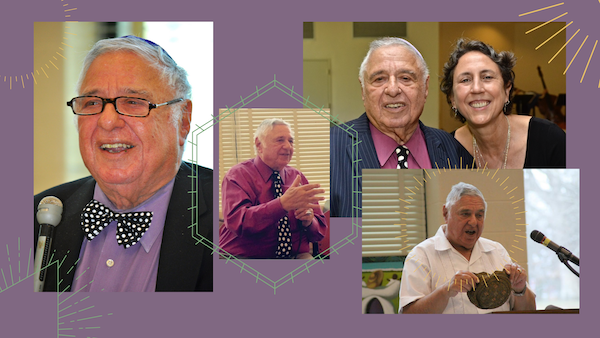On Sunday, March 7th, IFFP will be continuing its 25th-anniversary celebration by honoring our first Rabbi, Harold White. In this month’s blog post, we share a reflection written by Rabbi White on his own experiences with the Lenten and Passover holiday season.
December is often characterized as the “Christmas/Hanukkah dilemma,” particularly for inter-faith families. We seldom encounter that sense of “warfare” between Passover and Easter. The latter was not always true for the Jewish community. My experience of Christmas was basically positive. Santa Claus was a benevolent fantasy, who gave to rich and poor alike and never stayed around for a thank you. The Christmas light enlivened the gloom of winter and the toy departments certainly improved considerably with the addition of electric trains and other novelties that were not on the menu during the rest of the year. Easter was quite a different experience for me. My parents did not regard the Easter bunny as an enemy of Jewish faith or practice. The only time that the rabbit was a problem was when Easter occurred during the same week as Passover. The dilemma then centered about the reality that the chocolate rabbit was not Kosher for Passover. I remember the frustration of having to wait eight days before I could taste the chocolate confection. My parents never attended a Christmas Eve service. They did, however, relish, the fashions that were on display at the Easter parades emerging from church services. I recall a family visit to New York City where we patiently waited outside of St. Patrick’s Cathedral for the annual Easter show. The season had a dark aspect, however, for me personally and for the Jewish community historically.
I experienced seasonal anti-Semitism, namely, during the weeks preceding Easter. I cautiously avoided the playground of the parochial school in my neighborhood where I had previously been confronted with the allegation “Christ-killer.” These barbs came from the mouths of peers whom I had previously considered to be friends. I remember discussing this hurt with my grandmother who had been born in Eastern Europe. She explained to me that pogroms against the Jewish community were also seasonal, occurring regularly during Holy Week preceding Easter. I realized that Good Friday and the crucifixion narrative were responsible for my Passover/Easter dilemma. Much has changed in the post-Vatican II era. The liturgy of Good Friday eliminated controversial language although I still have difficulty with the Gospel of John, which was retained. I am similarly troubled by the possibility that Pope Benedict might allow the reintroduction of said passages within the liturgy.
While the historical “dark” side of Easter should be recognized by the Jewish community, the past remembrances must not inhibit the possibility of a more objective and healing view of the relationship between the two holy days of the Jewish and Christian calendar. I can identify a number of positive parallels.

The first involves the imperative to tend to the needs of the stranger. At the Passover Seder we open the door symbolically to welcome the stranger into our midst. We recite a passage from the Torah reminding us that we “cannot abhor an Egyptian because we were strangers in the land of Egypt.” The Seder is a welcoming table, the Jewish equivalent of the Eucharist experience of sharing a meal with individuals who were previously strangers to you. The matzoh offers us another opportunity for “inter-facing.” When the matzoh is first introduced to the gathering at the Seder table it is described as “the bread of poverty, the bread of affliction.” Just prior to the beginning of the meal, however, the matzoh assumes a very different characterization; namely “the bread of freedom and redemption.” One symbol assumes a dual identity of both agony and ecstasy. The parallel to Christian belief is the duality of the cross, which represents the pain and suffering of the crucifixion, but the hope and joy of redemption as well.
Inter-religious dialogue has a tendency to dwell upon similarities and the positive elements of interaction between religious communities. I believe in this process but must recall the specter of the past to insure the fact that history does not repeat itself.

